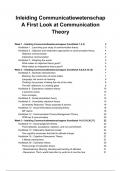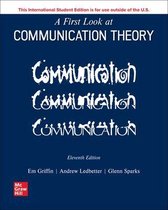Inleiding Communicatiewetenschap
A First Look at Communication
Theory
Week 1 - Inleiding Communicatiewetenschappen (hoofdstuk 1,2,3) 3
Hoofdstuk 1 : Launching your study of communication theory 3
Hoofdstuk 2 : Objective and interpretive approaches to communication theory 4
Objective communication 4
Interpretive communication 4
Hoofdstuk 3 : Weighing the words 5
What makes an objective theory good? 5
What makes an interpretive theory good? 6
Week 2 - Inleiding Communicatiewetenschappen (hoofdstuk 5,6,8,9,10,12) 7
Hoofdstuk 5 : Symbolic interactionism 7
Meaning: the construction of social reality 7
Language: the source of meaning 8
Thinking: the process of taking the role of the other 8
The self: reflections in a looking glass 8
Hoofdstuk 6 : Expectancy violations theory 10
4 proxemic zones: 10
Core concepts: 11
Hoofdstuk 8 : Social penetration theory 12
Hoofdstuk 9 : Uncertainty reduction theory 15
Uncertainty Reduction Theory proposes 8 axioms: 16
Hoofdstuk 10 : Social information processing theory 18
SIP claims 18
Hoofdstuk 12 : Communication Privacy Management Theory 20
CPM has 5 core principles 20
Week 3 - Inleiding Communicatiewetenschappen (hoofdstuk 14,15,16,36,37) 22
Hoofdstuk 14 : Social judgement theory 22
Three latitudes: acceptance, rejection, and non-commitment 22
Hoofdstuk 15 : Elaboration likelihood model 24
Two cognitive processes that lead to attitude change: 24
Hoofdstuk 16 : Cognitive Dissonance Theory 27
3 Mental mechanisms 27
Hoofdstuk 36 : Cultivation theory 30
Three prongs of cultivation theory 30
- Mainstreaming: Blurring, blending and bending of attitudes 31
- Resonance: The tv world looks like my world so it must be true 31
, Hoofdstuk 37 : Agenda-setting theory 33
Level 1: The media tell us what to think about 33
Level 2: The media tell us which attributes of issues are most important 33
Level 3: The media tell us which issues go together 33
Different agendas → 33
Begrippen deel 1 35
Week 4 - Inleiding Communicatiewetenschappen (hoofdstuk 20,21,22,24) 38
Chapter 20: Functional Perspective on Group Decision Making 38
Four functions of effective decision making 38
Chapter 21: Symbolic Convergence Theory 42
Chapter 22: Cultural Approach to Organizations 45
Clifford Geertz 45
Michael Pacanowsky 46
Chapter 24: Critical Theory of Communication in Organizations 48
Tabel - Four approaches to organizational practice 49
The dutch polder model 50
Week 5 - Inleiding Communicatiewetenschappen (hoofdstuk 17,19,31,32,35) 51
Chapter 17: The Rhetoric of Aristotle 51
Logos 51
Pathos 52
Ethos 52
The five canons of rhetoric 53
Chapter 19: Narrative Paradigm 55
Rational-world paradigm 55
Narrative paradigm 55
Chapter 31: Media Ecology 58
The tribal age 58
The age of literacy 59
The print age 59
The electronic age 59
The digital age? 59
Postman 59
Chapter 32: Context Collapse 61
1. Tailoring performances 62
2. Segmenting audiences 63
Chapter 35: Uses and Gratifications 64
Five key assumptions that underlie uses and gratifications 64
Alan Rubin typology of media uses and gratifications 65
Parasocial relationships 66
Week 6 - Inleiding Communicatiewetenschappen (hoofdstuk 25,27,29,30) 67
Chapter 25: Communication Accommodation Theory 67
Convergence: seeking accommodation 67
Divergence and other forms of non accommodation 67
Social identity theory 68
1
, Attribution Theory 70
→ Critique 70
Chapter 27: Co-Cultural Theory 72
Aggressive approach = Communication practices that are seen as hurtfully
expressive, self-promoting and assuming control over the choices of others. (De
behoeften van jezelf boven die van anderen stellen.) 73
Assimilation as a preferred outcome of communication 73
Accommodation as the preferred outcome of communication 74
Separation as a preferred outcome of communication 75
Phenomenology 76
Dominant group theory 77
Critique → 77
Chapter 29: Feminist Standpoint Theory 79
→ Critique 81
Chapter 30: Muted Group Theory 82
→ Critique 83
Begrippen deel 2 85
2
, Week 1 - Inleiding Communicatiewetenschappen
(hoofdstuk 1,2,3)
blz 2-12
Hoofdstuk 1 : Launching your study of communication theory
Communication = The relation process of creating and interpreting messages that elicit a
response. (Het proces van het creëren en interpreteren van berichten die een reactie
uitlokken.)
Theory = A set of systematic, informed hunches about the way things work.
In response to the question “What is a theory”, we’ve presented a verbal definition →
1. Theory as nets
Philosopher Karl Popper said that “Theories are nets cast to catch what we call ‘the world’,
we endeavor to make the mesh ever finer and finer.”
2. Theory as lenses
Many scholars see their theoretical constructions as similar to the lens of a camera or a pair
of glasses, as opposed to a mirror that accurately reflects the world out there. Two theorists
could analyze the same communication event (perhaps an argument about politics) and,
depending on the lens each uses, one theorist may view the speech act different than the
other theorist.
A danger of the lens metaphor is that we might regard what is seen as so dependent on the
theoretical lens of the viewer that we abandon any attempt to discern what is real or true.
3. Theory as maps
A good map helps us understand unfamiliar terrain. (Road maps, Political maps, Climate
maps)
But like a still photograph, no theory can fully portray the richness of interaction between
people that is constantly changing, always varied, and inevitably more complicated than
what any theory can chart.
3





